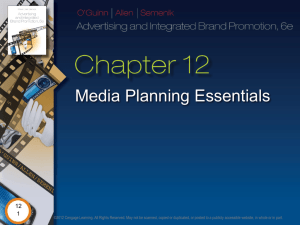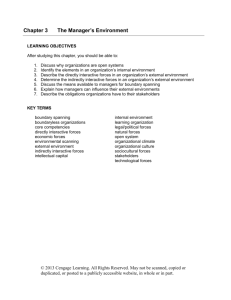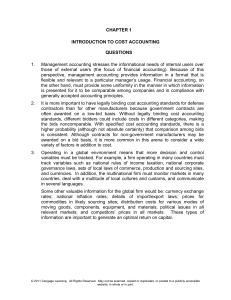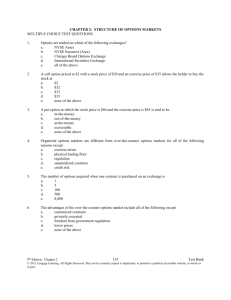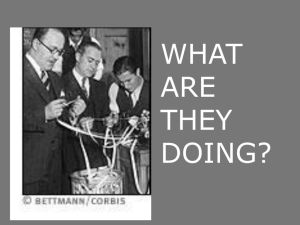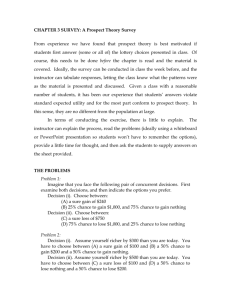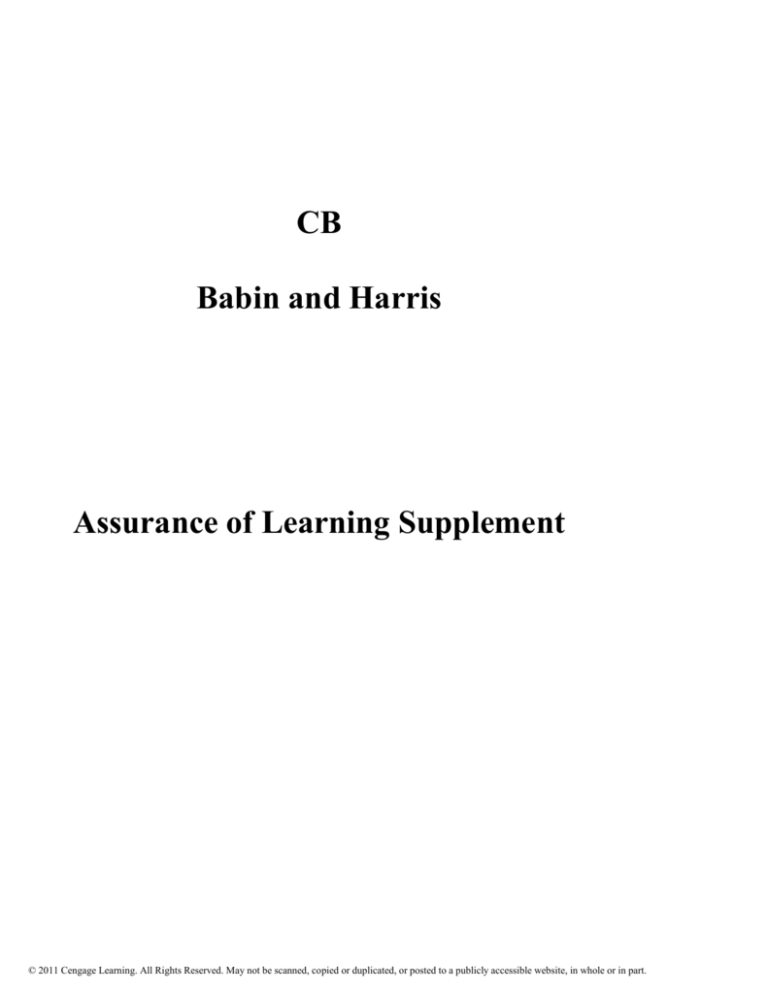
CB
Babin and Harris
Assurance of Learning Supplement
© 2011 Cengage Learning. All Rights Reserved. May not be scanned, copied or duplicated, or posted to a publicly accessible website, in whole or in part.
Cengage/Assurance of Learning Initiative
The recent establishment of learning outcome assurance requirements by the AACSB for
accreditation has led to a flurry of activity as schools respond to the new needs. Higher
education itself is in the midst of an assessment movement. The Spellings report, the
implementation of the “No child left behind” initiative in primary and secondary education, and
public policy demand for assessing the effectiveness due to interest in how state dollars are
being used in higher education. Recently imposed assurance of learning outcomes have
spawned a multitude of efforts on campuses across the country to begin the process of defining
program goals, embedding assessments, and measuring results. Part of the development of this
edition of CB has given us the opportunity to help faculty meet these needs. We have tagged test
items with general business outcomes and marketing discipline outcomes based tags that will
allow you to more easily produce learning outcomes reports for accreditation purposes.
These initiatives will help you and your colleagues in the assurance effort which will help your
institution:
Meet External Requirements: Help schools provide reliable documentation of
performance for AACSB or ACBSP and regional accreditation, strategic planning and
performance-based funding.
Perform Benchmarking and Trend Analysis: Facilitates comparison of scores to measure
student achievement, document program effectiveness and demonstrate program
improvement over time.
Developing and Improving Curricula: A variety of score reports allow for detailed
curriculum review and evaluation.
Assessing Student Achievement: Faculty and administrators can assess student level of
achievement.
Tagged Learning Objects
Our first initiative is to add an AACSB compliance and marketing discipline tagging to each
test item in CB. Since the embedded assessments are usually assigned in general business
school courses, the Consumer Behavior course, which is taken by all marketing and many
business majors, is an ideal place to track program learning outcomes.
Tracking the Assurance of Learning Initiative in ExamView
The ExamView testing system can help you keep track of the assessments and end of class
reports can be easily prepared and exported to a variety of Program Management Systems such
as True Outcomes, Taskstream, and STEPS.
Assurance of Course Learning Outcomes Using AACSB and Course specific objectives: What we are
doing now
© 2011 Cengage Learning. All Rights Reserved. May not be scanned, copied or duplicated, or posted to a publicly accessible website, in whole or in part.
Assurance of learning outcomes in business schools is now considered a general faculty responsibility
to ensure that students learn critical skills and acquire knowledge deemed important and appropriate by
college faculty members. As part of the program-level measurement of learning outcomes, the
measurement of specific program-level and course-level learning goals needs to occur in multiple
college-level core courses at various levels (freshman, sophomore, junior and senior).
The test bank is tagged to outcomes suggested by the Association to Advance Collegiate Schools of
Business (AACSB) and other marketing discipline-specific program outcomes.
We use a three tiered system. The first tier employs 6 general business program outcomes outlined in
their Standard 15 and used by the AACSB when assessing and accrediting institutions. Using this
information can help illustrate the effectiveness of a business program in addressing these learning
standards and can help the program gain AACSB or ACBSP accreditation. These tags
(Communication, Ethics, Analytic, technology, Diversity, and Reflective Thinking) and our
interpretation of how we assign the tags to appropriate assessment items are:
1. Communication abilities.
a. Organization of Ideas and Factual Information. An ability to organize ideas and factual
information into coherent, logical sequences that convey the intended message as
effectively as possible.
b. Written Presentation Skill. An ability to prepare written documents that are free of
mechanical errors, have sophisticated sentence and paragraph structure, and adhere to
APA or other appropriate guidelines.
c. Oral Presentation Skill. An ability to speak before an audience without embarrassment
or affectation and to use appropriate volume, inflection, pace, posture, body language
and other components of competent public speaking.
d. Graphical Presentation Skill. An ability to create images to communicate quantitative
and qualitative ideas and factual information. Graphics for quantitative information
include graphs of all types: pie, bar, line, scatter, box-and-whisker, histogram, Gantt
charts, etc. Students are expected to prepare graphs with appropriate axes, symbols,
legends, titles, annotations, use of color, animation, sound effects, etc. to elicit clear
understanding on the part of the viewer. Graphics for qualitative information include the
design of presentation media such as PowerPoint slides, symbolic images such as flow
charts and organizational charts, and photographic or artistic images that evoke
emotional responses appropriate to the intended message.
2. Ethical and Legal understanding and reasoning abilities.
a. Legal Responsibilities. Knowledge of legal responsibilities relevant to the student’s
profession and the ability to fulfill those responsibilities in professional practice.
b. Codes of Ethics. Knowledge of the codes of ethics of relevant professional
organizations as well as current theories of personal ethics and the ethics of societies and
organizations.
c. Ethical Decision Making. An ability to recognize ethical conflicts in real-world
environments, apply analytical tools to understand the consequences of various options,
and take action consistent with ethical integrity.
3. Business Knowledge and Analytic skills.
© 2011 Cengage Learning. All Rights Reserved. May not be scanned, copied or duplicated, or posted to a publicly accessible website, in whole or in part.
a. Economics. An understanding of how value is created through the integrated production
and distribution of goods, services, and information, and an ability to analyze (compare
and contrast, show causality, examine assumptions of) economic systems.
b. Finance. An understanding of current financial theories and markets; an ability to
analyze markets and financial reports; and an ability to prepare financial reports in
accordance with professional standards.
c. Organizational Behavior. An understanding of group and individual dynamics in
organizations, and an ability to analyze business policies from the perspective of
organizational behavior.
d. Statistics and Management Science. An ability to use statistical data analysis and
management science to support decision-making processes throughout an organization.
4. Use of Information Technology.
a. Technological Literacy. An ability to use current technology: Word Processing,
Spreadsheets, Presentation Software, Databases, Web Browsers, Search Engines,
Statistical Analysis Packages, Project Resources Planning Packages, Tax Preparation
Packages, Management Information Systems, and other software relevant to the
discipline, and an ability and desire to learn new technologies as they become available.
b. Technological Security. An understanding of the threats to information systems and
knowledge of how to minimize those threats.
c. Technology and Organizations. An understanding of how information technologies
influence the structure and processes of organizations and economies and how they
influence the roles and techniques of management.
5. Multicultural and Diversity Understanding.
a. An understanding of and respect for the cultural diversity of the United States and
knowledge of the historical context of our diverse nation.
b. An understanding of and respect for non-Western cultures.
c. An understanding of the domestic and global economic environments of organizations.
6. Reflective Thinking Skills.
a. An understanding that knowledge is constructed from evidence and can be changed and
reconstructed with the appearance of new evidence, perspectives, or methods of inquiry;
and the ability to “construct knowledge” by examining evidence and assumptions and
applying logical and reasoning to determine the most likely meaning of a particular
situation.
b. An ability and desire to regularly reexamine past experiences to clarify their meaning,
especially with respect to personal responses, behaviors and actions.
The second tier tags are more specific and use a set of marketing discipline-specific standards that we have
developed with a panel of faculty from across the nation.
Marketing Discipline tags
Tags
CB&C Model Strategy
CB&C Model Creativity
CB&C Model Customer
CB&C Model Marketing Plan
Skills
Strategically Analyzing Marketing Problems
Creativity and Innovation
Understanding the Customer
Marketing Fundamentals and Creating a Marketing
Plan
© 2011 Cengage Learning. All Rights Reserved. May not be scanned, copied or duplicated, or posted to a publicly accessible website, in whole or in part.
CB&C Model Promotion
CB&C Model Distribution
CB&C Model Product
CB&C Model Pricing
CB&C Model Research
CB&C Model Online/Computer
TB&E Model International perspective
Promotion Concepts/Strategy
Distribution Concepts/Strategy
Product Concepts/Strategy
Pricing Concepts/Strategy
Marketing Research
Ability to acquire, analyze, and interpret information
on a computer
Global marketing concepts/strategy
Recently, Robert S. Rubin and Erich C. Dierdorff presented a paper at the Academy of Management
Meeting (How Relevant is the MBA? Assessing the Alignment of MBA Curricula and Managerial
Competencies) that we felt derived the most comprehensive managerial competency model to date
relying on nationally representative data from 8,633 incumbents across 52 managerial occupations. We
have adapted their framework to define an additional set of Learning Outcomes for management
education for both undergraduate business majors and MBA’s. We would like to thank Robert S. Rubin
and Erich C. Dierdorff of DePaul University for heir work in developing this model and their
permission for us to adapt and use their framework. Their model of empirically derived managerial
work role requirements are grouped into Behavioral, Skill Based, Knowledge Based, and Work Style
requirements as follows.
Behavioral
Managing human capital
Managing logistics & technology
Managing decision-making processes
Managing administration & control
Managing strategy & innovation
Managing the task environment
Knowledge-based
Knowledge of technology, design, & production
Knowledge of human behavior & society
Knowledge of general business functions
Knowledge of media communications & delivery
Skill-based
Interpersonal skills
Operations skills
Strategic & systems skills
Foundational skills
Work style
Learning, motivation, & leadership
Interpersonal orientation
Conscientiousness
Generative thinking
How are these implemented? These tags were applied based on a subject matter expert interpretation
of the AACSB International accreditation standards, the marketing discipline standards, and the Rubin
and Dierdorff taxonomy of managerial competencies. Though there will always be some debate, we
© 2011 Cengage Learning. All Rights Reserved. May not be scanned, copied or duplicated, or posted to a publicly accessible website, in whole or in part.
welcome instructor’s feedback on the application of these tags, and we hope that, with our customer’s
assistance, we can make this system more and more effective in the coming years. We want our
customers to partner with us to improve this system and become part of the process.
Example of tagging in the CB test bank
© 2011 Cengage Learning. All Rights Reserved. May not be scanned, copied or duplicated, or posted to a publicly accessible website, in whole or in part.
Here is an example of how you can search for questions related specifically to the learning outcomes that you
want to measure when creating assignments, quizzes and exams.
The report generator in Examview can prepare Assurance of Learning reports that produce the class
list, and their achievement in meeting a program standard of learning. The report can be easily exported
in a variety of formats, including Excel, which can then be imported to a variety of Program
Management Systems. You can also easily export the artifact for inclusion in a program assessment
report prepared for your institution’s accreditation review.
© 2011 Cengage Learning. All Rights Reserved. May not be scanned, copied or duplicated, or posted to a publicly accessible website, in whole or in part.
Example of a report exported to Excel.
© 2011 Cengage Learning. All Rights Reserved. May not be scanned, copied or duplicated, or posted to a publicly accessible website, in whole or in part.







